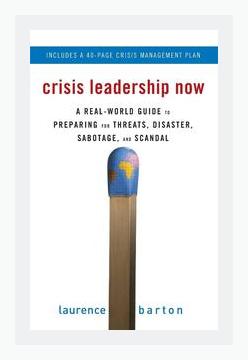Leadership and ManagementCrisis Management
Title: Crisis Leadership Now: A Real-World Guide to Preparing for Threats, Disaster, Sabotage, and Scandal
Author: Laurence Barton
Published: 2008
Categories: Crisis Management
1. Introduction to Crisis Management
Laurence Barton opens the book by defining what a crisis is and emphasizes that it can strike any organization at any time, causing significant disruption. He stresses the importance of preparedness, rapid response, and effective leadership.
Specific Action:
– Conduct a Risk Assessment: Regularly evaluate potential threats specific to your organization and develop preliminary responses for each scenario.
Example:
Barton highlights the 1982 Tylenol crisis, where Johnson & Johnson quickly recalled 31 million bottles after cyanide-laced capsules caused fatalities. This swift action underpinned the company’s strong reputation for crisis management.
2. Building a Crisis-Ready Culture
Barton asserts that an organization’s culture is key to effective crisis management. He recommends fostering a culture where every employee understands potential crises and their role in mitigating these situations.
Specific Action:
– Training Programs: Implement regular crisis management training for all employees to ensure awareness and readiness.
Example:
He mentions Southwest Airlines, which holds routine crisis simulations to ensure all staff are prepared to handle emergencies. This proactive approach maintains operational stability even during unexpected disruptions.
3. Crisis Communication Strategies
Effective communication is a cornerstone of crisis management. Barton delineates strategies for both internal and external communication during a crisis, emphasizing transparency and consistency.
Specific Action:
– Develop a Communication Plan: Create a structured communication plan detailing who communicates with whom, in what manner, and how frequently during a crisis.
Example:
During the anthrax attacks in 2001, the U.S. Postal Service kept its employees and the public informed through consistent, fact-based updates, which helped mitigate panic and confusion.
4. Preemptive Crisis Planning
Barton underscores the importance of preemptive planning to minimize the damage when a crisis actually hits. Drafting plans and practicing them creates muscle memory for real situations.
Specific Action:
– Create a Crisis Response Team: Establish and train a dedicated crisis response team responsible for leading the organization through potential crises.
Example:
Toyota created a global crisis-response network after their 2010 recall crisis. This structure enabled them to address subsequent issues more systematically and efficiently.
5. Identifying and Assessing Risks
Laurence Barton discusses how organizations should continuously identify and assess evolving risks. Understanding what could go wrong allows organizations to prepare adequately.
Specific Action:
– Risk Mapping: Constantly update a risk map that outlines potential threats and their impact on various areas of the organization.
Example:
Barton references a pharmaceutical company that regularly conducts risk assessments to stay ahead of potential safety hazards, protecting both its reputation and customer trust.
6. Crisis Leadership
Barton places significant emphasis on the role of leadership during a crisis, arguing that effective leaders can turn crises into opportunities for growth and improvement.
Specific Action:
– Leadership Development: Invest in leadership development programs that focus on decision-making under stress and crisis leadership skills.
Example:
He cites Rudy Giuliani’s leadership during the 9/11 attacks as a prime example. Giuliani’s calm, decisive actions and communication reassured the public and coordinated an effective emergency response.
7. Legal and Ethical Considerations
Addressing legal and ethical considerations in a crisis is crucial. Barton advises organizations to stay compliant with legal requirements while maintaining ethical standards.
Specific Action:
– Legal Counsel Involvement: Always include legal counsel on the crisis response team to ensure compliance and to guide ethical decision-making.
Example:
When Firestone tires were linked to accidents, the company’s delayed response and perceived ethical lapses led to a significant loss of public trust and legal repercussions.
8. The Role of Technology in Crisis Management
Barton explores the role of technology in detecting, managing, and resolving crises. He recommends leveraging modern tools for swift and efficient crisis management.
Specific Action:
– Implement Crisis Management Software: Adopt specialized software designed for crisis communication, incident tracking, and resource management.
Example:
He discusses the use of social media monitoring tools during a product recall to manage customer communication and gather real-time feedback.
9. Case Studies and Real-World Examples
The book is rich with case studies and examples, showing how real organizations have managed various crises.
Specific Action:
– Study Past Crises: Regularly review relevant case studies and apply lessons learned to improve your own crisis management plans.
Example:
Barton examines the Exxon Valdez oil spill, pointing out the importance of quick, transparent communication, which Exxon failed to provide, leading to a damaged reputation.
10. Post-Crisis Evaluation and Learning
After a crisis, Barton stresses the need for thorough evaluation to learn from the event and improve future responses.
Specific Action:
– Conduct Post-Mortem Reviews: After each crisis, hold review sessions to analyze what worked, what didn’t, and how the response can be improved.
Example:
Barton highlights Procter & Gamble, which holds detailed post-crisis reviews to continually refine their crisis management strategies.
Conclusion
Laurence Barton’s “Crisis Leadership Now” offers a comprehensive guide to preparing for and managing crises. From assessing risks and training teams to maintaining effective communication and learning from past crises, the book provides actionable insights and real-world examples designed to fortify organizations against any form of disruption. Following Barton’s advice can help leaders navigate crises more effectively, ultimately turning potential threats into opportunities for resilience and growth.
